1929 – 1941
After the First World War had ended, no country possessed the resources to rebuild their somewhat reduced merchant fleets. This especially concerned Germany who had been forced to hand over their important ships to Britain and America. Whilst the latter countries could maintain their ‘peace-fleet’ with German war-prizes, Germany had to start from scratch. With Albert Ballin’s giant Imperator-trio in foreign hands, nothing remained of the Empire’s former glory, save the Deutschland from the early 1900s who unfortunately was hopelessly outdated.
Although this was far from acceptable for the Germans, worse still was that the Blue Riband still was in British hands. The venerable old Mauretania from 1907 still ruled the waves with her 26.06-knot record. Germany had to do something.
In 1927, France managed to produce one of the most beautiful liners that have ever sailed the seas; the Île de France. That France had been able to do this in spite of its rather unvictorious way out of the war made Germany feel somewhat self-conscious; if France could do this – so could Germany. Instead of aiming for size and luxury, the Germans had their eyes on the Blue Riband of the Atlantic. After more than twenty years in British possession, it was time to hand it over to new holders.
The decision was made to commission two great liners from Norddeutscher Lloyd. They should be able to beat the Mauretania’s record over the Atlantic, but still have efforts put in interior, safety, and of course – size. The names of the two vessels were to be Bremen and Europa. The Bremen was appropriately decided to be built in the city of Bremen, whilst the Europa would be built in Hamburg. The reason why they were built at two different locations was that the Germans wanted to enter the Atlantic with two ships at once. The first of the two ships was supposed to be the Europa.
However, this would not be the case. The Europa suffered a devastating fire on board before completion, and so the glory of being the first of the duo was given to the Bremen. Actually, it was planned that not only Bremen and Europa would make a team on the North Atlantic. A third ship was supposed to make the duo into a trio; namely the Columbus, the ship that originally was to be named Hindenburg, sister to Britain’s Homeric (the ex-Columbus).
In August 1928, the launching of the Bremen was carried through. Now – once again the Germans could claim to operate one of the prime ships of the waves. But would the ship be able to regain the Blue Riband from the British? It would be awfully painful if the old Mauretania would keep the prize in British hands.
But, Germany’s fears were not to become true. On July 12, 1929, the Bremen set out on her maiden voyage. When she reached New York 4 days, 17 hours and 42 minutes later the pride of Germany had averaged 27.9 knots – well enough to regain the Blue Riband. The Mauretania tried for it again a few months later, averaging 26.9 on the westbound crossing and 27.22 on the eastbound – beating her own record time by five hours, but the honour remained Germany’s.
The ship had been built with the Blue Riband in mind, just as the Lusitania and Mauretania 22 years earlier, but there were more things to be impressed on board the Bremen than her speed. The ship’s exterior look was something quite new. The stern was of the new spoon-shaped appearance and the large 50,000-tonner only carried two funnels. Another interesting feature was that the ship’s beam was greater than any other liner’s. At 102 feet, many believed it was too wide for a speed champion. Up until then all ‘fast’ ships were built with a narrow beam to ‘slice’ through the water, but new technology proved this unnecessary.
The new technology also made the Bremen carry several new devices on board. For instance the ship had an automatic pilot called ‘Metal Mike’ that was able to steer the ship right through the stormiest of weathers. And, if you wanted to measure the Bremen’s speed this was easily done. A new Swedish tool called ‘Den Svenska Log.’ made it possible. The invention consisted of having a pipe attached to the ship’s bottom where water would penetrate. The water that went through the pipe had a wheel in it, and by measuring the wheel’s turnings, you could make out the ship’s present speed. Of course, this did not work in stormy waters, but it was still an interesting feature for the sea-people of the twenties.
The safety of ocean liners had since the Titanic-disaster in 1912 always been one of the highest priorities. The Bremen naturally followed the trend, and did certainly not lack in any safety equipment. On the Upper Promenade Deck, the Bremen was equipped with white lifeboats stretching from the superstructure’s beginning to its end. Every one of these lifeboats had small engines able to drive the boat’s single propeller. The boat’s fuel tanks were always full, and the engine-system was oiled and served every day. In these boats alone there were room for 3,848 people, 800 more than the ship’s entire capacity. Added to these lifeboats, several rafts and rubber boats were available.
The engines of the Bremen and the Europa were the most powerful that had ever been constructed. They consisted of four turbines of 25,000 horsepower each, making the ship’s entire power to 100,000 H.P., which is 30,000 more than the Mauretania had. The electrical equipment on board was powered by a separate Diesel engine.
The ship’s rudder was also a novelty. Whilst the old-type rudders had merely been a construction of a flat steel plate, the Bremen’s rudder was streamlined and not massive, but filled with marine glue and cork, which made the rudder much lighter, deleting the annoying extra dead-weight at a ship’s absolute stern.
Just as on the Île de France, the Bremen carried a catapult-aeroplane-launcher. To be ranked as a fast ship the Bremen also had to have a fast mail service across the Atlantic. When the ship was a bit outside the American coast, the aeroplane took off with the assistance of the catapult and arrived with the mail a couple of hours before the ship steamed into the harbour. Simple and practical.
The Bremen became a popular ship on the Atlantic as customary with the world’s fastest ship. Very briefly after the Bremen had entered service, her sister – the Europa – arrived. She took the westbound crossing record from her sister, but by 1933, the Bremen was master in both directions again. In that year, the Italian liner Rex of 1933 took the westbound crossing, and in 1935, the Bremen lost the eastbound honour to the fabled French liner Normandie. The ship remained in Norddeutscher Lloyd service until World War II in 1939. In August the Bremen was at New York, but hindered to sail, because the British had asked the Americans to stop the Bremen from adding to Germany’s power. The British wanted to send a cruiser to escort the Bremen into their hands in Europe. When the cruiser was in position the Bremen finally went out of New York harbour, the ship’s orchestra playing ‘Deutschland Über Alles’. Whilst at sea, the Bremen suddenly sped on and left the slower cruiser behind. The Bremen managed to escape the British cruiser’s eye contact after a couple of days. After that, no one knew what had happened to the Bremen until mid-October. Had the giant 50,000-tonner been sunk by a British or American battleship? No – the ship had actually turned its way north after the escape, and during that part of the voyage, the ship’s crew managed to heel over the Bremen’s side and paint the entire ship grey to camouflage her. After having landed the most part of the crew at Murmansk, the Bremen carefully made its way along the Norwegian coast and finally arrived home in Germany in December 1939. The British had to do more than that in order to capture Germany’s pride of the seas.
When the Bremen had arrived to Germany, the county’s authorities decided to have the ship laid up. At first, both the Bremen and the Europa was supposed to become armed troop-transports, but when the ship appeared too heavy with artillery on her upper decks, it was decided to only use the ships as troop-transports. But this never occurred. The only task the Bremen completed during the war was to be an accommodation ship for soldiers.
The end for the ship came in a very tragic and unnecessary way. Whilst the ship was moored at her berth at Bremerhaven in March 1941, an unhappy crewmember decided to end the days of the Bremen. He managed to set the entire ship afire, and there was no way anyone could save the ship. The sad remains of the former Blue Riband champion were cut up and sent to Nazi munitions plants. The Bremen had become yet another German ship to be lost to the rage of war.
Specifications
- 938 feet (286.5 m) long
- 102 feet (31.2 m) wide
- 51,656 gross tons
- Four 25,000 hp turbines powering four propellers
- 27 knot service speed
- Passenger capacity of 2,200 people

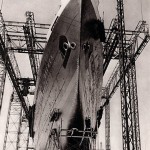
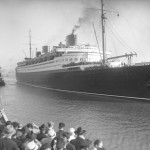

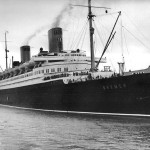
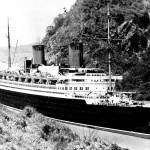
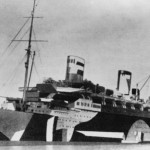
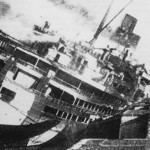
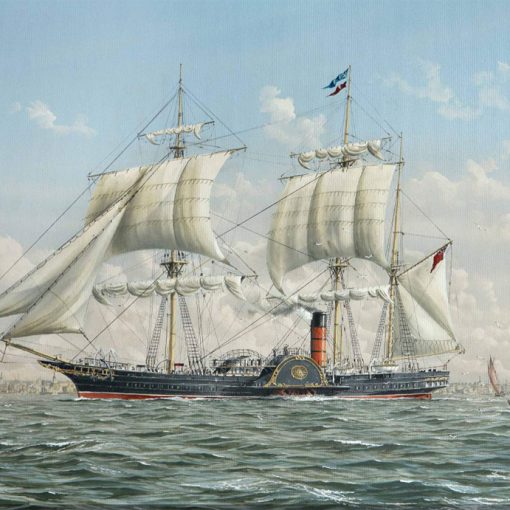
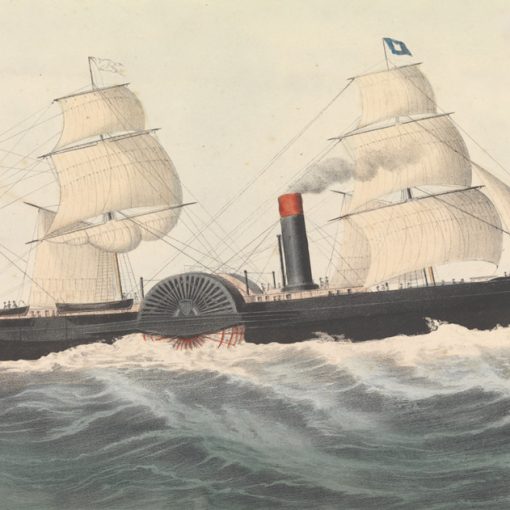
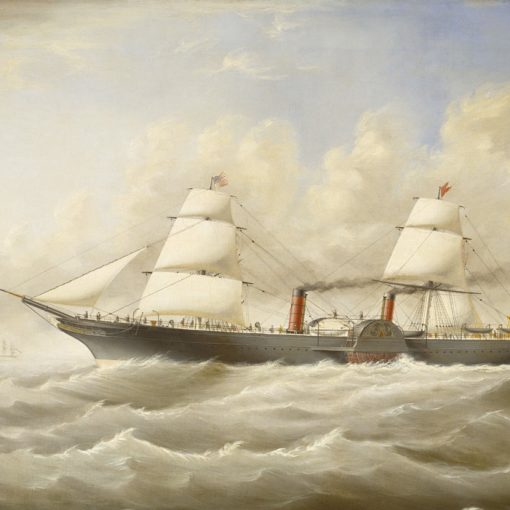
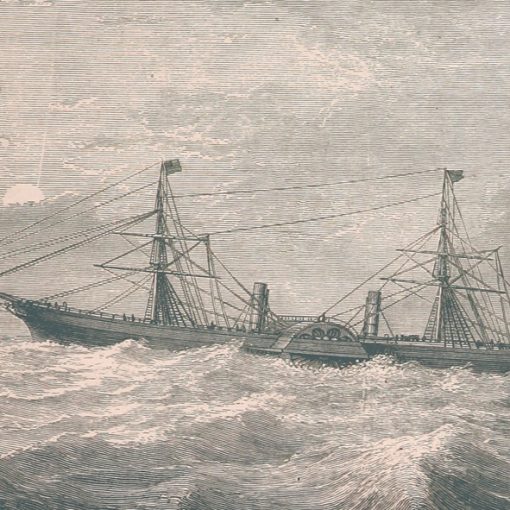
One thought on “Bremen”
I have a cigarette lighter my father purchased on the Europa when he came to America from Switzerland. It is like brand new today.